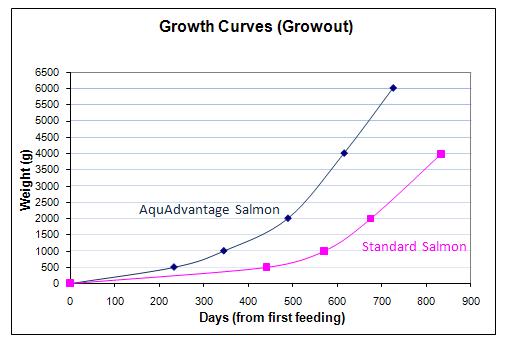A Fight for More Scrutiny: The First GMO Animal Built for Human Consumption
 Thursday, February 9, 2012 at 10:56AM
Thursday, February 9, 2012 at 10:56AM  Blink and you'll miss a critically important moment in the effort to keep genetically engineered animals out of the food supply. This week three consumer groups (Food & Water Watch, Consumers Union, and the Center for Food Safety) petitioned the FDA to reclassify a genetically engineered salmon and make it subject to more stringent regulatory scrutiny (currently the GMO salmon is classified as a "new animal drug," a designation for animals used to create drug ingredients.) The salmon in question (called the AquAdvantage salmon, quietly under development in the private sector for 15 years) has been genetically engineered to grow twice as fast as natural salmon in captivity; it eats 5 times as much food as its unaltered counterparts. If approved, AquAdvantage salmon would be the first genetically engineered animal made for human consumption.
Blink and you'll miss a critically important moment in the effort to keep genetically engineered animals out of the food supply. This week three consumer groups (Food & Water Watch, Consumers Union, and the Center for Food Safety) petitioned the FDA to reclassify a genetically engineered salmon and make it subject to more stringent regulatory scrutiny (currently the GMO salmon is classified as a "new animal drug," a designation for animals used to create drug ingredients.) The salmon in question (called the AquAdvantage salmon, quietly under development in the private sector for 15 years) has been genetically engineered to grow twice as fast as natural salmon in captivity; it eats 5 times as much food as its unaltered counterparts. If approved, AquAdvantage salmon would be the first genetically engineered animal made for human consumption.
One of the differences between GMO and standard fish, according to the report, was the "presence of inflammation of unknown cause in some tissues."
Members of the FDA’s own advisory committee have described the agency’s current review as lacking in rigor. Consumer groups point out that the salmon grower's own studies reveal the transgenic salmon (which would be hatched on Prince Edward Island in Canada and reared in Panama, making it free of some U.S. regulations) may contain increased levels of IGF-1, a hormone that helps accelerate the growth of the transgenic fish and is linked to breast, colon, prostate, and lung cancer.
 Mutant Salmon: Grow twice as big in their first year of life as their counterparts in nature according to this chart from Aquabounty Technologies..The salmon's parent company, Aqua Bounty Technologies (located in Waltham, MA) has put a lot of thought into not letting their spawn escape (because that's where regualtory efforts focus under the fish's current classification,) but very little research has been conducted into the potential health effects of eating such fish. A quick look at the technology begs the question: are these animals even salmon? Aqua Bounty's report to the FDA puts it this way, "Studies of AquAdvantage Salmon have demonstrated that they are similar in many ways to their non-transgenic counterparts, but very different in other respects." One of the differences between GMO and standard fish, according to the report, was the "presence of inflammation of unknown cause in some tissues." Not wildly appetizing, we must admit.
Mutant Salmon: Grow twice as big in their first year of life as their counterparts in nature according to this chart from Aquabounty Technologies..The salmon's parent company, Aqua Bounty Technologies (located in Waltham, MA) has put a lot of thought into not letting their spawn escape (because that's where regualtory efforts focus under the fish's current classification,) but very little research has been conducted into the potential health effects of eating such fish. A quick look at the technology begs the question: are these animals even salmon? Aqua Bounty's report to the FDA puts it this way, "Studies of AquAdvantage Salmon have demonstrated that they are similar in many ways to their non-transgenic counterparts, but very different in other respects." One of the differences between GMO and standard fish, according to the report, was the "presence of inflammation of unknown cause in some tissues." Not wildly appetizing, we must admit.
At the inception of the project more than a decade ago a wild salmon was brought into the lab and its DNA was inserted with two genes from other fish (a chinook and an ocean pout.) The new genes control growth rates and increase them to levels beyond standard salmon. The original wild salmon was mated until successive generations began to express the new gene and grow rapidly in captivity. Not only do the GMO salmon eat a lot, but they are unconcerned about eating in the presence of predators--one of the reasons Aqua Bounty is confident its mutant fish won't take over the world.
One of the weirder aspects of this sci-fi fish is what's been done to stop it from propagating if it does escape. The GMO eggs are all female, and they are subject to a lab process that results in triploidy (giving them three instead of two of each chromosome) rendering them sterile so that even if they escape they can't reproduce. The fish on your plate might have unnaturally elevated levels of growth hormone and an extra chromosome. You want that grilled, poached or baked?
 Kathy |
Kathy |  Post a Comment |
Post a Comment | 
Reader Comments